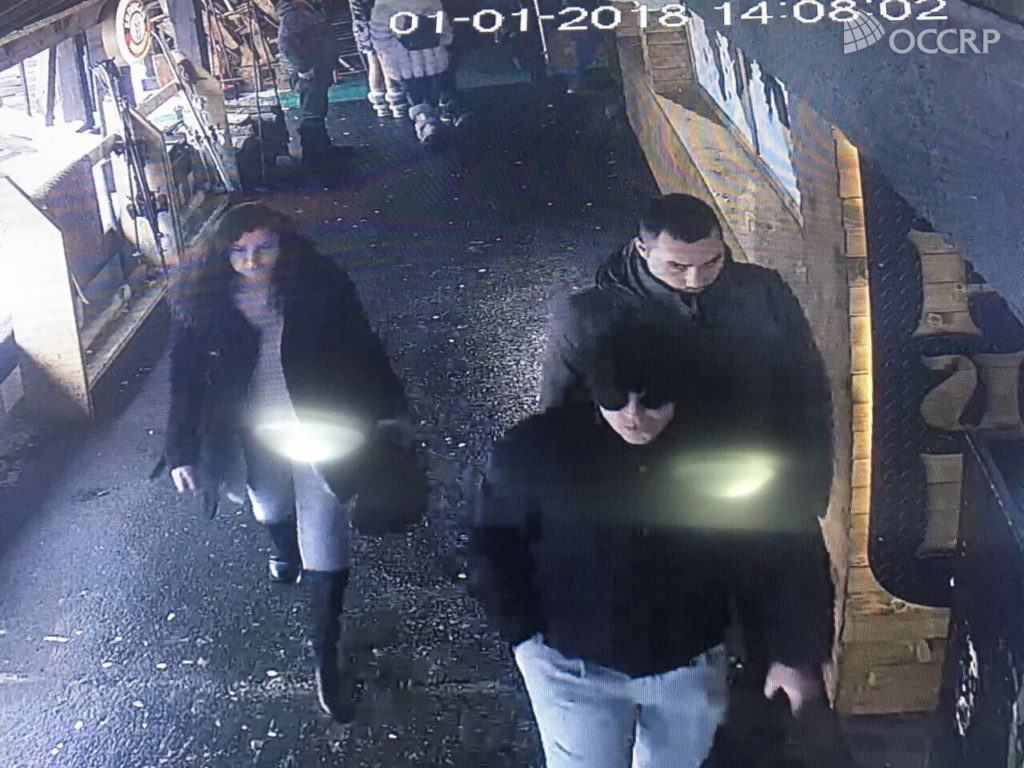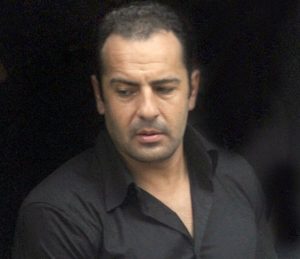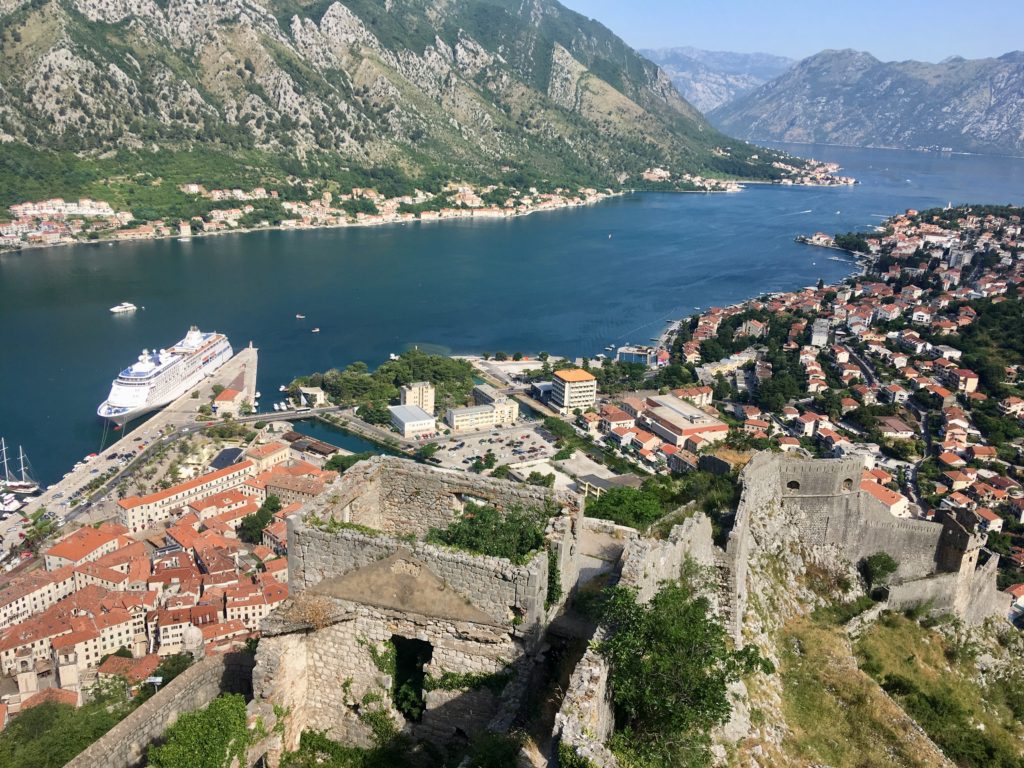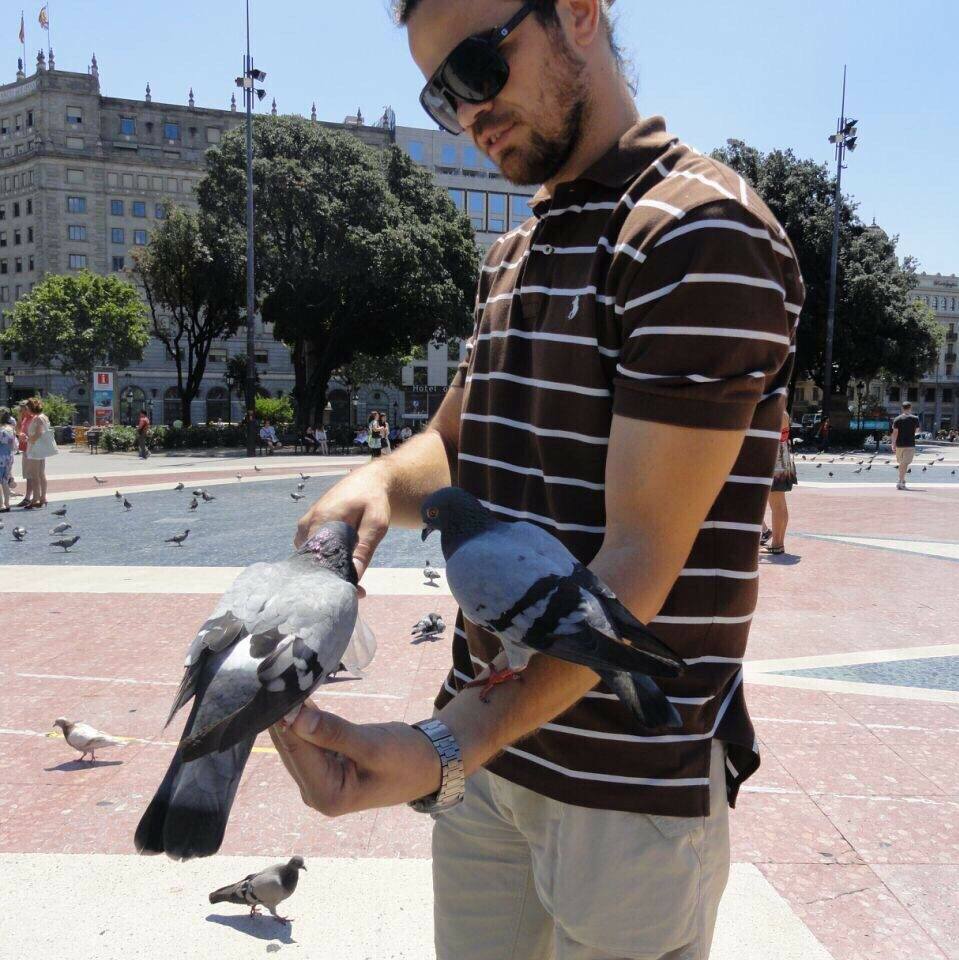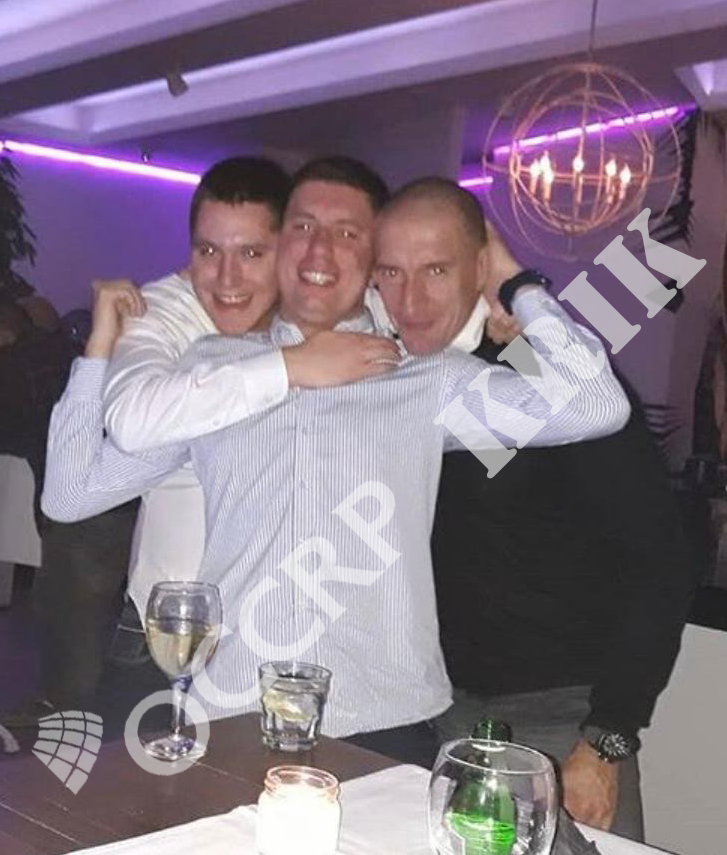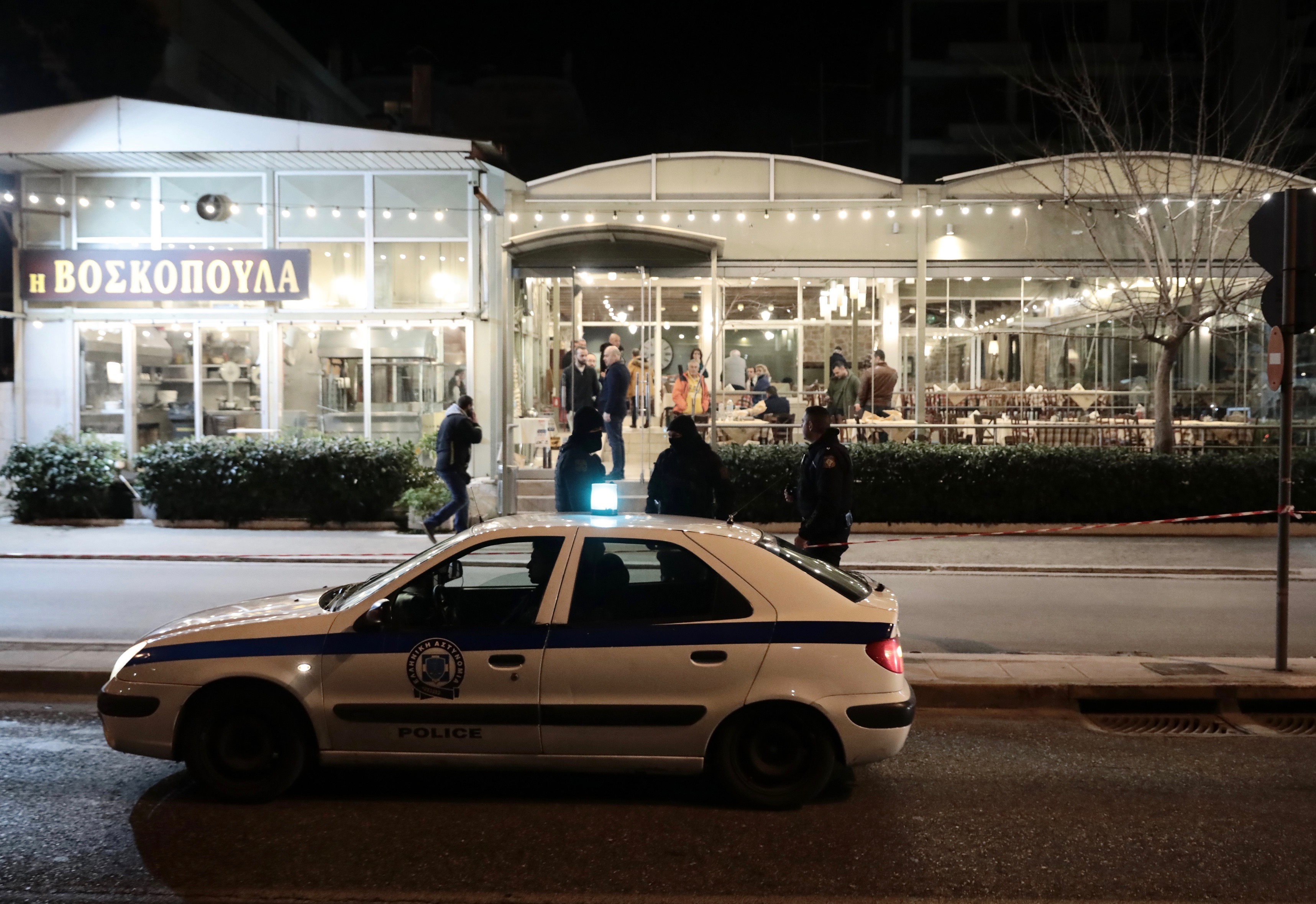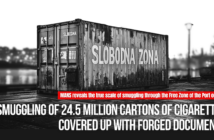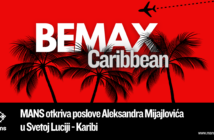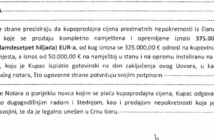A police officer, a football hooligan, and a member of a Montenegrin criminal gang walk through a ski resort in the mountains of southern Serbia.
Nine hours later, and halfway across the country, the gangster is dead in a Belgrade parking garage after a hail of bullets fired into the Volkswagen Golf he was driving. The same police officer sits unscathed in the passenger seat, as the attackers flee.
The scenes, which a source said were shot at Kopaonik ski resort and in Belgrade, were captured in January 2018 by CCTV cameras in both locations. The images were obtained by KRIK, OCCRP’s member center in Serbia, and have not previously been seen publicly.
The murder and the meeting hours earlier between the police officer, the Kavač gang member, and the football hooligan — such men often provide muscle for corrupt politicians and crime groups — highlight the complex web of allegiances at play in an increasingly brutal war between two Montenegrin criminal organizations.
The Kavač and Škaljari clans both hail from Kotor, on Montenegro’s picturesque Adriatic coast. They were once part of the same gang smuggling drugs from South America into Europe, but split in 2014 after a cocaine deal in Spain went bad, creating a violent rift that has deepened ever since — and pulled in other Serbian and Montenegrin crime groups
“The scale of the conflict between the ‘Škaljari’ and the ‘Kavač’ clans is seen in the findings that, in the criminal milieu in Montenegro and Serbia, a significant division occurred,” Serbia’s intelligence agency wrote in a February 2018 report obtained by KRIK.
“Most significant organized criminal groups have decided to join one of these two rival criminal groups.”
An investigation by KRIK and OCCRP’s Montenegrin member center, MANS, shows that the conflict has spread even further than the Serbian intelligence report lets on.
Reporters gathered documents from police, courts, and intelligence agencies; pored over obituaries of gangsters; and spoke to about a dozen sources familiar with the Balkan criminal scene. Together, the evidence shows that the Kavač-Škaljari drug war has upended the region’s underworld. Even some Serbian and Montenegrin police and politicians have sided with the Kavač faction.
The Kavač organized crime group has aligned with football hooligans tied to high-level Serbian politicians, while the Škaljari have joined forces with a powerful Serbian organization led by Filip Korać, which the classified intelligence report labels “one of most dangerous crime groups operating internationally.”
Reporters identified at least 41 people who likely have been killed in relation to the conflict since 2015, according to information from official documents and interviews with knowledgeable sources.
Most recently, an alleged member of the Škaljari was killed and another injured while transporting a bomb, according to police. The car they were in exploded the evening of March 4 in a residential neighbourhood on the outskirts of Montenegro’s quiet capital, Podgorica.
Among the dead are gangsters, but also their family members and associates, including a lawyer and a former Montenegrin parliamentarian whose best man was a Škaljari gang member. One innocent bystander was killed by a stray bullet in a cafe in Montenegro’s capital, Podgorica, when a crime clan member was murdered by an assassin wearing a lifelike silicone mask.
The trail of blood stretches across the Balkans and beyond, with murders in Spain, Germany, Austria, the Netherlands, and Greece. In January, a leader of the Škaljari and another clan member were gunned down in an Athens restaurant in front of their wives and children. One of the women was also “lightly injured,” according to Montenegrin police.
Many of the murders have been carried out with professional precision.
The hit in the Belgrade parking garage, for example, was committed by two men following the Volkswagen on foot, one armed with a pistol and the other with what looked like a semi-automatic rifle, the CCTV footage shows. The assassins circled the vehicle, firing multiple rounds and killing Davorin Baltić, the Kavač member, without injuring the police officer, Marija Nikolić.
Nikolić is now on trial in Serbia for disposing of Baltić’s handgun after the attack. She testified that she was in shock and did not know why she decided to toss the gun in a garbage bin three streets away. She said Baltić had told her to grab it for him from a pocket in the passenger side door when the shooting began.
Nikolić testified that she was in the parking garage with him in the building where he lives with his wife — who is a friend of hers — because she was assigned to walk a beat in the same neighborhood, and he had given her a ride.
Nikolić also told the court she had gone with Baltić earlier in the day to Kopaonik ski resort, which is about a four-hour drive from Belgrade. However, neither the judge nor prosecution have so far asked what the purpose of that trip was. The fact that Nikolić and Baltić met there with Uroš Ljubojević, a member of a football hooligan group associated with the Kavač, has not previously been revealed.
The still image taken from CCTV footage showing them together at the high-end resort provides a rare glimpse into ties between police, organized crime, and football hooligans. Further investigation by reporters also shows close links between some Serbian politicians and hooligan groups.
BROTHERS IN ARMS
The roots of the Balkan crime-clan war go back to 2014. Before that, members of the clans were all part of a single group, known as the Škaljari, that had built up a highly effective and lucrative international cocaine smuggling network.
Serbian intelligence noted in its classified report that crime groups from Serbia “are relatively highly ranked in the hierarchy of international criminal organizations specializing in drug smuggling and illegal trafficking.”
Over the past two decades, Serbian-Montenegrin crime groups have created a worldwide logistics network and established “bases” in ex-Yugoslav countries, Europe, and the United States, as well as Latin America, where they are “capable in a short period of time of organizing the supply of large quantities of drugs from local drug cartels.”
Montenegrin groups in particular have become specialists in “cocaine transport service via routine routes from Latin America to some European sea cities, under the guise of transporting legal goods.” They are able to draw on “criminal connections with crews of ocean liners of some transnational companies.”
The intelligence report noted that the Balkan drug-smuggling gangs had also become experts at laundering “enormous amounts of money” they were making.
But despite this organizational success, fractures were emerging within the Montenegrin crime group due to “increasingly frequent conflicts … about the allocation of illegally acquired money,” according to the report.
Tensions finally exploded in Valencia in 2014 in a dispute over 200 kg of cocaine, according to Serbian intelligence and other sources knowledgeable about the criminal underworld.
Sources told OCCRP that Škaljari members discovered an unexpected 200 kg in a warehouse they were using to store their drugs. The Kavač faction of the gang admitted it belonged to them, and offered to pay off the Škaljari, who refused and told them: “Now you will be punished. These are our drugs now,” according to a source.
Violence ensued, cementing the schism between the clans, which have roots in the same region of Montenegro.
Both groups are named after areas around Kotor, an ancient settlement nestled in a bay that meanders inland from the Adriatic Sea. Founded by the Romans and occupied by various empires, Kotor’s old city is a maze of alleyways surrounded by stone walls that crawl up the arid mountainside overhead.
Today, Kotor is packed with tourists. Some may end up strolling down Škaljari street or wandering through Kavač village, unaware of the bloodshed those names have come to signify. Five of the clan-related murders confirmed by reporters occurred in Kotor, including the April 2019 killing of the father of Jovan Vukotić, who allegedly leads the Škaljari.
Kotor’s former municipal president, Vladimir Jokić, said it was well-known that local clans were involved in criminal activities. He called for international pressure on Montenegro’s government to crack down on the crime groups, and accused police of turning a blind eye to the mayhem they were creating.
“I knew everything about those criminal clans 10 years ago,” Jokić said over coffee in Kotor’s bustling main square, just inside the gates of the old city. “Everybody knew.”
“I can never understand how it is possible for the international community not to react to these criminal activities, to these clans, to these smuggled drugs.”
Montenegro has pledged to crack down on organized crime, both as part of its accession process to the European Union, and as a member of NATO, which it joined in 2017. Despite the transnational nature of the cocaine trade, and the fact that killings have occurred in fellow member states, a NATO official said in an email that resolving such “domestic issues” is the “sovereign prerogative of individual countries.”
Montenegro’s Special Public Prosecutor’s Office, which is charged with fighting organized crime, did not respond to a request for comment.
The European Union delegation to Montenegro said in an email that criminal organizations from that country “have direct links to crime groups in South America, which gives them a dominant position for the supply of cocaine to Europe. They operate largely outside Montenegro, including in EU countries.”
The delegation said in an email that “the EU has a close policy dialogue and an intense cooperation with the Montenegrin authorities,” and funds programs aimed at fighting organized crime and corruption. There have been successes, including working with Italian authorities on a 2018 bust that yielded 200 million euros worth of hashish, but shortcomings remain.
“There is a need for strong political will to effectively address corruption issues, as well as a robust criminal justice response to high-level corruption,” the delegation said.
THE BLOODBATH BEGINS
As the conflict heated up, killings and planned assassinations became more brazen. In a 2018 indictment against members of a crime group aligned with the Škaljari, a protected witness said he had been told of plans to kill Montenegrin Chief Special Prosecutor Milivoje Katnić.
“If you cannot kill Katnić, you could kill his son, who doesn’t pay attention to where he goes,” the witness said he was told by the leader of a group aligned with the Škaljari. “He’s often with his girlfriend and he’s an easy target.”
The number of cocaine clan-related murders is likely much higher than the 41 reporters were able to verify by cross-referencing different sources. Some names were included in official documents, while others turned up in news reports and obituaries. Their identities and affiliations were then confirmed by sources who have deep knowledge of the Balkan criminal underworld, or are involved in it themselves.
The cocaine clans have killed each other using car bombs and remotely-triggered roadside explosives, as well as shootings carried out by members. In at least two cases, expert snipers were hired from outside the organizations.
In 2016, Dalibor Đurić, an important Škaljari member sentenced for extortion, was taking an exercise break in the yard at Spuž prison, near Podgorica, when a bullet ripped through his chest and exited his back. His left lung had been demolished by a sniper hiding on the opposite bank of the Zeta River, which curves around the prison, according to an indictment of two accomplices to the murder.
The accomplices helped the killer escape by pouring petrol on the vehicle he had used and burned it, along with the rifle, destroying the evidence. Montenegrin newspapers reported that they were convicted of the crime, but the sniper has never been identified.
In other cases, hired killers were far less professional.
In 2015, the Kavač recruited a 24-year-old would-be assassin from South Africa named Gregory Michael Ferraris. He was arrested before he could kill his target, but the statement he gave Montenegrin prosecutors provides insight into the lengths criminal groups sometimes go to in arranging such murders.
Ferraris said he met Aleksandar Marković, believed to be a Kavač member, when they were both applying for the French Foreign Legion, an arm of France’s military established in 1831. “I was not accepted because of my past, because I used the drug cocaine,” he told Montenegrin prosecutors.
While at the Foreign Legion recruitment center in Paris, Ferraris said he also met an American mercenary who told him he had just come from Iraq. He had “Isis Hunting Club” tattooed on his hand. He had a tattoo of a skull emblazoned with the French flag on one shoulder, and a skull with an American flag on the other. Ferraris said Marković told him the American had been hired to carry out a difficult assassination.
“I was not planned for that murder, because they need someone who was specially trained to silently get into the house, silently do that, and quietly get out,” Ferraris told prosecutors.
A month after they first met, Marković offered Ferraris 50,000 euros for a hit, although the young South African had never killed anyone before. “I accepted Aleksandar’s suggestion to join them and commit murder, because I was totally out of money,” he said in his statement.
Marković bought Ferraris a flight to Belgrade. From there he took a train to Serbia’s border with Montenegro and crossed over on foot with the help of a guide. Kavač gang members picked him up on the other side of the border, he told prosecutors. They changed vehicles several times on the way to Budva, a busy coastal city 23 km from Kotor.
There, he was taken to an apartment where he was told to wait until he was given the green light to kill his target: Goran Đuričković, owner of the Old Fisherman’s Pub on Budva’s waterfront promenade, and an alleged member of the Škaljari.
“Aleksandar told me that the owner of that restaurant and people around him were involved in stealing 200 kg of cocaine,” Ferraris said in his statement, referring to the dispute in Valencia. “He told me to shoot him at least five times, so the murder would send a message to everyone in Montenegro who are in the business of selling drugs.”
Ferraris said after waiting a long time for the kill order, he started having second thoughts. “I was thinking of giving up,” he said. “But I did not tell anyone, because they said that one person who was supposed to commit another murder gave up — so they killed that person.”
Before he could carry out the murder, Ferraris was stopped by police while driving a BMW X5 wearing surgical gloves to avoid leaving fingerprints. Police took him in for questioning, because he was not carrying identification, and discovered that the car’s licence plate was fake. Under representation by a state-appointed lawyer, Ferraris decided to confess the whole story of his recruitment by the Kavač.
During trial, Ferraris was represented by Borivoje Borović, a prominent lawyer from Belgrade. He advised his client to retract his previous statement, and Ferraris did not identify any Kavač members while on the stand. Nevertheless, a judge sentenced Ferraris to five years in prison. Marković, the Kavač member who recruited him, was given six years.
Đuričković suspected he was a target, according to a statement he gave to police after the 2015 murder of his close friend, the former Montenegrin parliamentarian Saša Marković. He told police he didn’t know why Marković was killed, but he feared it was due to their relationship. Đuričković said he was aware of “tensions” over the dispute about the 200 kg of cocaine in Valencia, and that his name had been mentioned in that context.
Đuričković may have dodged a bullet when Ferraris was arrested, but he met a violent death just months later. He had just stood up from a table in his restaurant when three shots rang out and he fell into the sea, according to media reports. A statement by prosecutors said two bullets hit a nearby wall and one struck him in the chest.
The suspected killer was Srđan Popović, a sniper from Republika Srpska, the Bosnian Serb region of Bosnia and Herzegovina. Popović fired downwards from the stone wall that surrounds the old town of Budva, according to prosecutors. He aimed his German-manufactured Heckler & Koch G3A4 rifle through an embrasure, a lookout hole in the wall used hundreds of years ago for archers or gunners to defend the city.
Some murders were more simply executed.
Goran Lenac, a football player close to Kavač clan members, was in the middle of his daily training routine in the stadium in Kotor in September 2017. An acquaintance, Nikola Mršić, walked up and shot him in the head with a pistol, according to an indictment. Mršić, who was identified as a member of a crime group associated with the Škaljari, fled the scene and was arrested in Serbia in March this year.
POLITICAL FOOTBALL
Football plays a major role in the Balkan organized crime scene. Young men known by the English term “hooligans” support specific teams and sell drugs on the street. They also form a ragtag army ready to provide muscle in wars to control territory and dominate the drug trade. Reporters have uncovered evidence that hooligan groups are connected to cocaine clans, as well as some Serbian politicians.
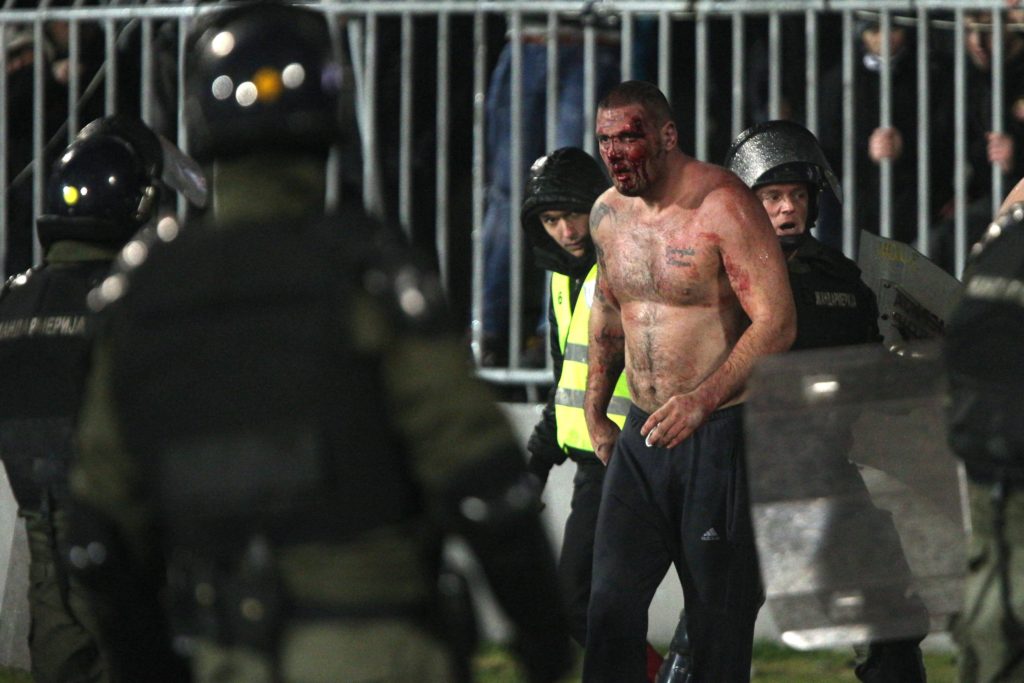
Beograd, 13.12.2017. – Sukob navijaca na juznoj tribini tokom utakmice 22. kola Super lige Srbije izmedju Partizana i Crvene zvezde, danas na stadionu Partizana u Beogradu. (BETAPHOTO/BRANISLAV BOZIC/DS)
After splitting off from the Škaljari, the Kavač aligned with the Janissaries, a hooligan group that provided them with an important link to members of Serbia’s current government. The Janissaries — a reference to the elite military corps who were recruited mostly from the Balkans and served Ottoman sultans — were led by Aleksandar Stanković until he was killed in 2016.
Stanković, also known as “Sale the Mute,” was connected to the highest levels of Serbian politics. Members of Stanković’s gang provided security for the 2017 inauguration of President Aleksandar Vučić, where they assaulted protesters and journalists. Vučić’s son, Danilo, is friends with Aleksandar Vidojević, one of the most powerful members of the Janissaries.
Photos show Vidojević and Danilo Vučić together watching Serbia play Costa Rica in a World Cup match in Samara, Russia, in June 2018. They were also photographed together in January in Banja Luka, the main city and administrative center of Republika Srpska, on the day celebrating the declaration of that entity. In another never-before-published photograph obtained by KRIK, the younger Vučić embraces Vidojević inside a bar.
Another link between Stanković and Serbia’s president is Novak Nedić. He served as Vučić’s general secretary when he was prime minister, and during that time he and Stanković practiced their weapons skills at a military-owned shooting range.
In addition to political relationships, Stanković was connected to Nenad Vučković, a high-ranking police officer. Photos show them together at two football matches.
THE DEATH BLOW
Stanković’s political and police connections may explain the government’s reaction to his murder. He was cut down in a barrage of machine-gun fire while getting into his Audi A6 on an autumn night in Belgrade in 2016. No one was ever charged for the murder, but the Serbian intelligence report points to Škaljari members Stevan Stamatović and Milić Minja Šaković.
The day after the killing, Serbian Minister of Police Nebojša Stefanović held a press conference at which he stated: “We declare war on the mafia and enter this war without reservation.”
But instead of indiscriminately targeting organized crime, the government’s war appears to weigh heavily on one side. Police have focused on the Škaljari and their allies in the criminal organization headed by Korać, which Serbian intelligence called “one of most dangerous crime groups operating internationally.”
Serbian officials have repeatedly made public statements about the dangers posed by the Škaljari and Korać, whom Vučić excoriated for “poisoning our children” with drugs. Yet, they rarely mention the Kavač, who are involved in the same illicit activities, including cocaine trafficking.
Pro-government tabloid newspapers and websites also focus on the Škaljari. A November 2016 front page of the Srpski Telegraf, for example, carried a photo of Stamatović with the headline: “This man wanted Vučić’s head,” referring to the current president, who was prime minister at the time.
Most tellingly, police have arrested four Škaljari members, including its leader, while no senior Kavač have been arrested. Stefanović, the minister of police, argued that the discrepancy was because the Škaljari were more prominent, and he denied that criminals were targeted due to “clan affiliation.”
“The activity of the Škaljari clan is more intense and more members of this clan are involved in criminal activities in Serbia,” he said at a January 2019 press conference in response to a question by KRIK.
Škaljari leader Vukotić was extradited to Serbia in September 2018 after being arrested in Turkey. He was travelling with an illegal passport, which had been produced by authorities of the Former Yugoslav Republic of Macedonia under a fake name. He told the court he was using a false identity because Montenegrin police were supplying information about him to criminals.
Montenegrin prosecutors have accused Zlatko Samardžić, a police officer and assistant to Kotor’s police chief, of passing intelligence to a Kavač member. They exchanged coded messages over the phone app Viber, according to an indictment obtained by reporters.
“I will come for the syrup,” Samardžić told his Kavač contact, warning him that police were planning to search the apartments of gang members.
In February, Vukotić was extradited to Montenegro where he faces charges of attempted murder and possession of an illegal weapon.
In addition to pressure from police, the Škaljari have been hit hard by their criminal rivals. Facing unprecedented threats on their home turf, members left for other European countries. But some have been murdered there too.
The fatal blow to the organization may have been the attack in the Athens restaurant in January, when two top members were killed. Attackers gunned down Stamatović — whom Serbian intelligence suspects is behind the killing of the hooligan leader, Stanković — and Igor Dedović, who led the Škaljari along with Vukotić.
In an obituary for Dedović placed in a Montenegrin newspaper, Vukotić wrote: “Your death gives us even more strength not to give up.”
Yet, with Dedović dead and Vukotić in a Montenegrin prison awaiting trial, the Škaljari are thought to be largely a spent force, opening up a power vacuum in the region’s criminal underworld.
One man ready to step into the void appears to be Korać, with his powerful crime group. His whereabouts are unknown, because he was hiding from an arrest warrant in Serbia for incitement to commit murder. But the charges against him were dropped in December 2019 for lack of evidence, prompting outrage from members of the government, including Serbia’s president.
In January, Vučić declared Korać to be one of the “most dangerous men in our country.”

